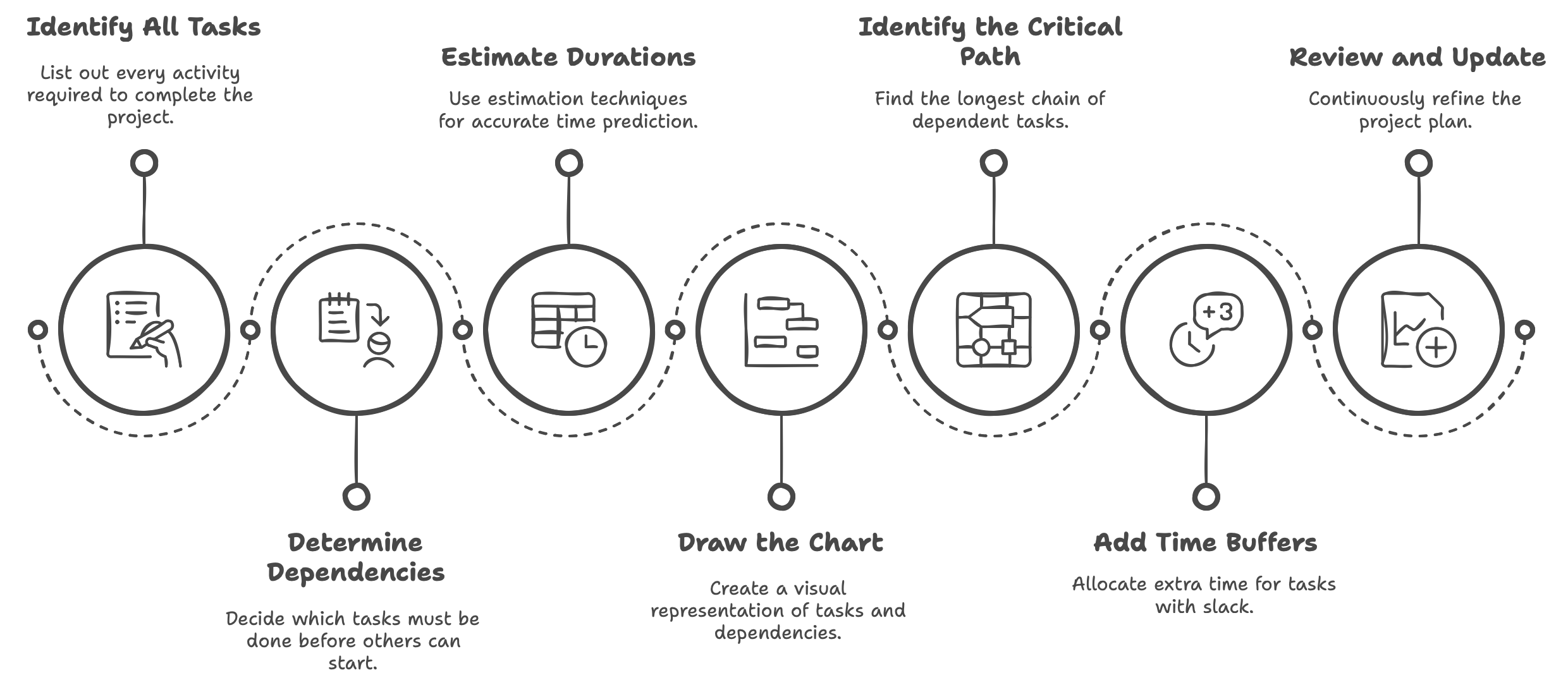Gestion de Projet avec une Touche de Magie
Planifiez, pilotez et livrez vos projets efficacement. Merlin Project pour macOS et iOS

Les diagrammes PERT sont un outil de base en gestion de projet pour organiser, planifier et coordonner les activités. Découvrez-en les avantages et les inconvénients.
Table des Matières
Qu’est-ce qu’un diagramme PERT ?
Avantages et inconvénients d’un diagramme PERT
La méthodologie PERT : calcul de la durée
Comment créer un diagramme PERT étape par étape
Quand utiliser un diagramme PERT par rapport à d’autres outils
Exemple : calcul de la durée d’une tâche avec PERT
Conseils pratiques
Conclusion
Un diagramme PERT (Program Evaluation and Review Technique) est un outil de gestion de projet conçu pour visualiser les activités d’un projet, leurs dépendances logiques et leur séquence chronologique. Il va au-delà de l’organigramme des tâches (WBS) en mettant en évidence non seulement les liens entre les tâches, mais aussi l’ordre dans lequel elles doivent être exécutées. Ainsi, les chefs de projet peuvent identifier le chemin critique (c’est-à-dire la séquence d’activités qui détermine directement la durée globale du projet) et tout tampon de temps (slack) éventuel.
Astuce : Découvrez le Merlin Project Learning Path pour plus de conseils et d’astuces en gestion de projet
| Avantages | Inconvénients |
|---|---|
| L’élaboration du diagramme PERT oblige à réfléchir à l’ensemble du projet et non à de simples sous-domaines. Ainsi, les points en suspens deviennent visibles. | Sa création est relativement complexe. |
| Le plan de réseau offre une vue d’ensemble pertinente de toutes les activités du projet et de leurs interdépendances. | La présentation requiert une formation pour en saisir pleinement la teneur. |
| Le plan peut être facilement mis à jour. | Plus le plan est détaillé, plus la surveillance et le contrôle sont importants pour éviter les erreurs de planification. |
| Une planification relativement précise et donc une réduction des coûts est envisageable. | La méthode est surdimensionnée pour les petits projets. |
| Les goulots d’étranglement (chemin critique et marges) sont faciles à repérer. | |
| Le plan de réseau peut être conçu indépendamment des hypothèses de calendrier. | |
| C’est un outil de communication clair pour les responsables de projet. |
Astuce : Les techniques de plan de réseau (y compris les diagrammes PERT) sont particulièrement utiles pour les projets complexes et de grande envergure. Pour des initiatives plus simples ou plus courtes, vous pouvez envisager des méthodes de gestion de projet agiles avec Kanban ou des diagrammes de Gantt, qui sont plus intuitifs et moins longs à mettre en place.
Un des traits distinctifs de la méthode PERT est sa manière d’estimer le temps nécessaire à chaque tâche. Au lieu d’une valeur unique, PERT emploie trois estimations pour mieux rendre compte de l’incertitude :
À partir de ces trois valeurs, PERT calcule une durée attendue (TE) pour chaque activité, selon la formule courante :
TE = (O + 4M + P) / 6
Vous pouvez également déterminer la variance ou l’écart-type pour évaluer les probabilités de finir à temps. De nombreux logiciels de gestion de projet (comme Merlin Project) effectuent ces calculs automatiquement.
Bien que la plupart des outils de gestion de projet automatisent une grande partie des opérations, il est important de comprendre le processus sous-jacent :

Identifiez toutes les tâches
Déterminez les dépendances
Estimez les durées
Élaborez le diagramme
Identifiez le chemin critique
Ajoutez des marges de temps
Révisez et mettez à jour

La gestion de projet moderne s’appuie sur de nombreuses méthodes et outils, adaptés à différents types et tailles de projets :
Point essentiel : PERT peut être intégré à des approches hybrides. Certains groupes utilisent un diagramme PERT pour la vue d’ensemble et un tableau Kanban ou Scrum pour la gestion quotidienne des tâches.
Supposons la tâche Développer un prototype
Formule :
TE = (O + 4M + P) / 6TE = (5 + 4*8 + 14) / 6TE = (5 + 32 + 14) / 6 = 51 / 6 ≈ 8,5 jours
Vous planifierez donc environ 8,5 jours pour cette tâche. Plusieurs logiciels de gestion de projet proposent d’entrer ces trois estimations, puis calculent automatiquement la durée attendue.
Un diagramme PERT est bien plus qu’une simple illustration : c’est un outil stratégique de planification qui vous aide à cerner les projets complexes, à déterminer le chemin critique et à intégrer les incertitudes dans vos estimations de temps. Bien qu’il exige davantage d’efforts que des méthodes plus simples comme les diagrammes de Gantt ou les tableaux Kanban, il se révèle précieux pour les projets de grande envergure et riches en interdépendances.
Avec les logiciels modernes qui automatisent calculs, mises à jour et apprentissage, intégrer PERT dans votre processus peut rehausser significativement vos compétences en gestion de projet.
Vos idées, notre magie – Réalisez vos projets en toute simplicité!
Essayez maintenant gratuitement pendant 30 jours.
